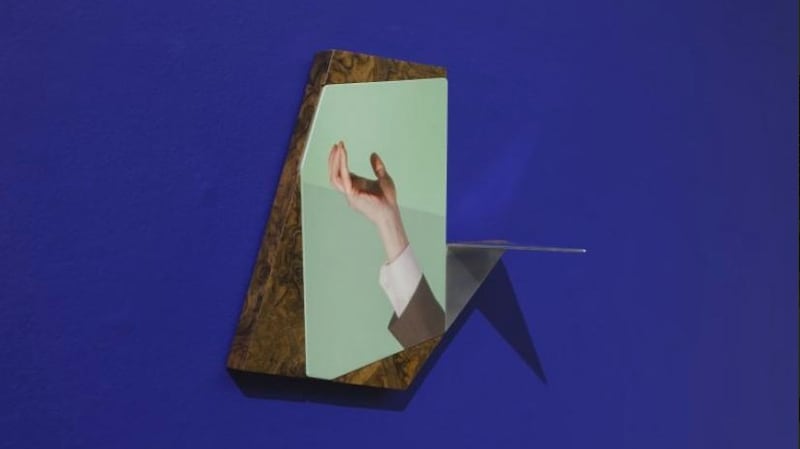Niamh McCann: Furtive Tears
Dublin City Gallery, The Hugh Lane, Parnell Sq
★★★
Una furtiva lagrima, an aria from Donizetti's opera L'Elisir d'amore, was reputedly one of James Joyce's favourite tunes. He sang it, and he mentioned it in the Cyclops episode of Ulysses. The furtive tear in question is glimpsed, ambiguously, by the besotted protagonist Nemorino, in the corner of his beloved's eye as he treats her dismissively. She's a wealthy landowner, he's a poor peasant. At a later point in the narrative, he takes the glimpsed tear as confirmation of her feelings for him. The elixir he consumes, incidentally, peddled by a quack, is merely alcohol.
Joyce is not mentioned in the extensive battery of references accompanying Niamh McCann's exhibition Furtive Tears, though there is something Joycean in the way the show is so densely packed with layer on layer of references: nothing is allowed to be innocently itself. Synthesis is also elusive. Lest we think that she is trying to rope together too many disparate strands, McCann has a pre-emptive rationale: "The world is dissonant and vast . . . In that respect, the collage form is accurate in its own way, making new landscapes of information or images as a form of examination."
While the statement “the collage form is accurate in its own way” is meaningless, the underlying implication is presumably that McCann is proceeding by means of collage, yoking together disparate things with the intention that juxtaposition will enhance and perhaps alter understanding.
A collage of ideas, especially of cultural signifiers, is a reasonable description of her exhibition.
Furtive Tears arrives under the umbrella of the Hugh Lane's Artist as Witness project. McCann is a retrospective, revisionist witness to a phase of Irish history about 100 years back. Specifically, in the show's video centerpiece, Furtive Tears, Salomé's Lament, she looks to Edward Carson, often perceived as the embodiment of militant unionism, nowhere more so than in the defiant bronze statue that greets visitors at Stormont. Arm raised, Carson is imaginatively captured at the moment in September 1911 when he addressed a rally of about 50,000 people near Belfast and proposed that the unionists take control of Ulster in defiance of the momentum towards Home Rule.

Carson was pivotal in the political developments that delivered partition and Northern Ireland in 1921, but he is generally recognised as being a more complex and on occasion ambivalent figure than the unionist stereotype suggests (well before his death in 1935, for example, he felt the unionist project had gone awry). McCann has an actor as Carson, musing in the rotunda of Belfast City Hall – where he signed the Solemn League and Covenant, formalising his unionist strategy, in 1912.
The tenuous link here is that the Tycho in question, astronomer Tycho Brahe, was injured in a duel and had a prosthetic brass nose
The dramatised Carson, dubbed Boris for some reason, does little, but occasionally lurches into the dramatic pose of Carson's statue. He is soberly attired but for one detail: red high-heeled shoes. He is abruptly transposed to the walkers' path on Black Mountain above Belfast, still in high heels but now dressed in a pantomime panda costume, complete with a huge head, a gesture that recalls the title character in Lenny Abrahamson's Frank, who wears a big papier-mâché head throughout. Identity is performative?
A separate video has Carson/Boris struggling to maintain his balance against a backdrop of a lunar crater, the Tycho Basin. The tenuous link here is that the Tycho in question, astronomer Tycho Brahe, was injured in a duel and had a prosthetic brass nose, which McCann links to a bronze made from a cast of Séamus Murphy’s bust of Michael Collins (the cast is included in the show).
A similar line of chance connection is followed in the second part of her video title, Salomé's Lament. The composer David Coonan, who is interested in the creative possibilities of recycling, has composed a quizzical, tentative piece based on Donizetti meets Richard Strauss, as in his opera Salomé. The source for the opera was a German translation of Oscar Wilde's Salomé. Wilde was in prison by the time his play was staged. Carson had been a fellow-student of his at Trinity, and Carson as barrister defended the Marquess of Queensbury against Wilde's charge of libel, to catastrophic effect for Wilde. But Carson declined to have anything to do with the subsequent prosecution of Wilde, and appealed for clemency on his behalf.
Add vases of wax flowers, a nod to Hugh Lane’s request that fresh flowers be supplied daily in his gallery, and a great deal more ancillary or tangential material, and you have an agreeable if ultimately inconsequential experience. A long-term interest of McCann’s, the German architect Hans Poelzig, featured in the show’s pre-publicity and its accompanying texts, but in the event is of little or no relevance to what’s on offer. She casts her net far and wide, and gathers together whatever is caught in its weave, but she never quite figures out what to do with it all, and the collage is never more than the sum of its myriad parts.
Until January 6th hughlane.ie












